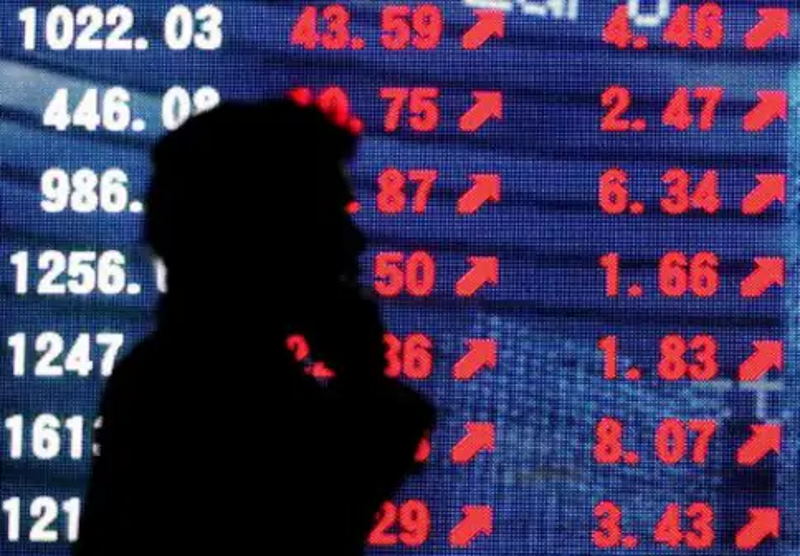Asian stocks fall as hawkish Fed reverberates; Treasury yields slide

Asian stocks dropped on Monday after last week’s surprise hawkish shift by the U.S. Federal Reserve reduced the allure of riskier assets, while the Treasury yield curve flattened further with 30-year yields dropping below 2%.
Japan’s Nikkei led declines with a 3.6% drop and dipped below 28,000 for the first time in a month, while MSCI’s broadest index of Asia-Pacific shares outside Japan fell 1.4%. Chinese blue chips lost 0.7%.
European stocks looked set to decline, with EuroSTOXX 50 futures down 1% and FTSE futures off 0.7%.
Benchmark 10-year U.S. Treasury yields fell to the lowest since Feb. 24 at 1.3540%, while those on 30-year bonds slid as low as 1.9290% for the first time since Feb. 11.
The yield curve – measured by the spread between two- and 30-year yields – was the flattest since late January as investors brought forward rate hike expectations while lowering the longer-term outlook for growth and inflation.
The U.S. dollar hovered near the 10-week high touched on Friday versus major peers, following its biggest weekly advance in more than a year.
“The story of last week was arguably the one-way move in the USD, which morphed into a clear de-grossing through equity markets, with the ‘value’ parts of the market really getting clobbered,” Chris Weston, the head of research at Pepperstone Markets Ltd, a foreign exchange broker based in Melbourne, wrote in a client note.
“It feels that the pain trade is for further strength in the USD, higher real rates, and a flatter Treasury curve, with the market continuing to see the reflation trades unwound.”
Shares of banks, energy firms and other companies that tend to be sensitive to the economy’s fluctuations have fallen sharply following the Fed’s meeting on Wednesday, when the central bank caught investors off guard by anticipating two quarter-percentage-point rate increases in 2023.
St. Louis Fed President James Bullard further fuelled the sell-off on Friday by saying the shift toward faster policy tightening was a “natural” response to economic growth and particularly inflation moving quicker than expected as the country reopens from the coronavirus pandemic.
“The Fed’s pivot to begin the tightening discussion caught most by surprise, but markets began discounting this inevitable process months ago in our view,” Morgan Stanley analysts wrote in a report.
“It’s exactly what the mid-cycle transition is all about, and fits nicely with our narrative for choppier equity markets and a 10-20% correction for the broader indices this year.”
The MSCI world equity index, which tracks shares in 45 nations, fell another 0.3% on Monday, extending its retreat from a record intraday high reached Tuesday.
U.S. stock futures pointed to further selling when Wall Street reopens, easing 0.4% after Friday’s 1.3% slide in the S&P 500.
Several Fed officials have speaking duties this week, including Chair Jerome Powell, who testifies before Congress on Tuesday.
European Central Bank President Christine Lagarde speaks before the European Parliament on Monday.
The euro traded near the lowest since April 6 at $1.1863 on Monday, dropping from as high as $1.21457 last Tuesday.
Sterling continue to take a beating, falling as low as $1.37865 for the first time since April 16.
Commodity-linked currencies have also suffered, with the Australian dollar hovering near a six-month low at $0.7492.
A stronger greenback has pressured cryptocurrencies too, with bitcoin falling 4.2% to around $34,112, while smaller rival ether lost 5.7% to around $2,115.
In commodities, gold rebounded 0.6% to $1,773.12 an ounce on Monday, looking to snap a six-day losing streak, but still remained near the lowest since early May.
Three-month copper on the London Metal Exchange fell to its lowest since April 15, following an 8.6% drop last week, the biggest weekly fall since March 2020.
Crude oil rose for a second day, underpinned by strong demand during the summer driving season and a pause in talks to revive the Iran nuclear deal that could indicate a delay in resumption of supplies from the OPEC producer.
Brent crude futures rose 22 cents to $73.73 a barrel, while U.S. West Texas Intermediate (WTI) crude rose 28 cents to $71.92 a barrel.

